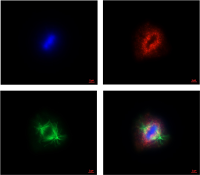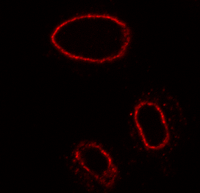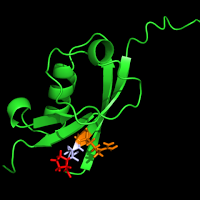Research focus
Biochemical and functional analysis of Nuclear pore complex, Nup107-160 and ELYS
(Saurabh Mehta, Sajeev TK)

Nuclear pore exclusively mediate all the transport that take place between nucleus and cytoplasm. These pores are made up of protein called Nups and these Nups play critical regulatory roles in nucelo-cytoplasmic transport. In mitotic cells, several Nups are present on kinetochores where they have been implicated in regulating cell division, microtubule formation etc. We are interested in understanding the importance of Nups during development and are using
Drosophila melanogaster as model organism. We are biochemically and genetically characterizing Nup107-160 complex and dual nucleoporin ELYS in Drosophila. Mansi and Saurabh are striving their best to decipher the importance of these molecules.Analysis of role of nuclear pore proteins (Nup) in cancer progression and metastasis (Usha Singh and Vidhi Makani)

Nups are known to be dysregulated in cancer. Chromosomal translocation mediated roles of Nups in cancer was known for long. Recently, association of Nup over-expression is being appreciated for their involvement in cancer. Expression levels of Nups like Nup88 and Nup107 can be correlated with cancer progression and metastasis. Nup over-expression is suggested to cause an imbalance of transport and abnormalities in cell division. Usha and Vidhi are keen on understanding how these Nups affect cancer progression and metastasis. Biochemical and cell biological analysis of important regulators of Nup88 and Nup107 current focus of their studies. How these nuclear pore proteins help regulate cell division by mediating nucleo-cytoplasmic transport is a piece of puzzle that we are trying to put together.
Molecular and structural understanding of sumo and sumoylation in Plasmodium (Mansi Gujrati, Usha Singh, Nimisha)

Post translation modification by sumo is known to play important role in regulating localization and function of many proteins including transcription factors, signaling molecules etc. Extensive work on sumo suggests that small C-terminal region of sumo harbors interaction sites for substrate and enzymes of the pathway. We are trying to understand residue level importance of the N-terminal region of human Sumo. Mansi, Nimisha & Usha interested in delineating the importance of N-terminal region of sumo and identifying substrates of sumo under various different physiological conditions.
Characterization of Sumo modification machinery in the causative agent for malaria, Plasmodium falciparum, has got us interested in under-standing this pathway in further detail. Mansi, Nimisha and Pearl are trying to get detailed information about Plasmodium sumo and its interactions. We are keenly pursuing the idea of identifying sumo substrates those are critical for survival of Plasmodium. We are also exploring the importance of sumo machinery in infection and malaria pathogenesis. It will be interesting to observe if these substrates can be targeted for malaria cure.
